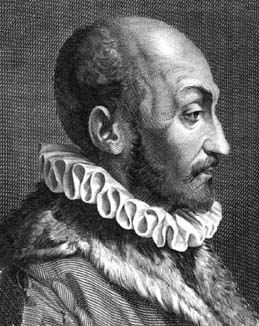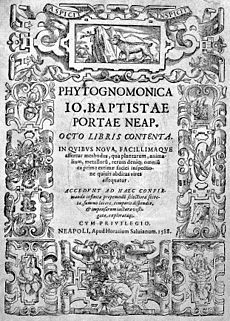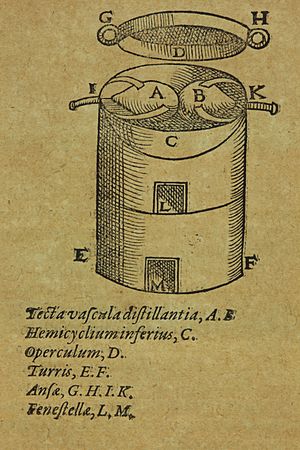Giambattista della Porta facts for kids
Quick facts for kids
Giambattista della Porta
|
|
|---|---|

Giambattista della Porta in 1589
|
|
| Born | late 1535 Vico Equense, Kingdom of Naples
|
| Died | 4 February 1615 (aged 79) Naples, Kingdom of Naples
|
| Nationality | Italian |
| Scientific career | |
| Fields | Occultism, astrology, alchemy, mathematics, meteorology, and natural philosophy |
Giambattista della Porta (1535 – 4 February 1615) was an Italian scholar and polymath (someone who knows a lot about many different subjects). He lived in Naples during the exciting times of the Renaissance (a period of great art and learning) and the Scientific Revolution.
Giambattista della Porta spent most of his life exploring science. He learned from tutors and famous scholars who visited his home. His most well-known book, first published in 1558, is called Magia Naturalis (which means Natural Magic). In this book, he wrote about many topics he studied, like astrology (the study of how stars might affect people), alchemy (an old form of chemistry), mathematics, and meteorology (the study of weather). People sometimes called him the "professor of secrets."
Contents
Early Life and Learning
Giambattista della Porta was born in Vico Equense, near Naples. His father, Nardo Antonio della Porta, was a nobleman who loved learning. Giambattista was one of four sons, and his father made sure all his children had a great education.
Their home was like a special school. Philosophers, mathematicians, poets, and musicians often visited. These smart friends helped teach and guide the boys. This helped Giambattista and his brothers become very curious about many subjects.
The brothers were also very interested in the arts, especially music. Even though they weren't naturally talented musicians, they worked hard to learn about music theory. They were even accepted into the Scuola di Pitagora, a very special music academy.
Their father wanted his sons to be gentlemen, not just scholars. So, they learned skills like dancing, riding, and dressing well. This gave Giambattista a taste for a privileged life, especially when he was younger.
Amazing Scientific Discoveries
Secret Codes and Messages
In 1563, della Porta published a book called De Furtivis Literarum Notis. This book was all about cryptography, which is the art of writing and solving secret codes. In it, he described one of the first known ways to use two letters to replace another, making codes harder to break. A famous expert named Charles J. Mendelsohn said della Porta was the best code-maker of his time.
Della Porta also invented a clever way to write secret messages inside eggs! Some of his friends were in prison, and guards checked everything except eggs. Della Porta used a special ink made from plants and alum. He wrote messages on the eggshell, and the ink would go through the shell. When the egg dried, he boiled it, and the ink on the outside washed away. The person in prison could then peel the egg and find the message on the egg white!
Understanding People and Nature
In 1586, della Porta wrote a book about physiognomy. This is the idea that you can tell a person's character from their face. This book influenced later thinkers.
Della Porta wrote about many different topics throughout his life. He created an encyclopedia about farming called "Villa." He also wrote books on meteorology (weather), optics (how light works), and astronomy (the study of stars and planets).
In 1589, della Porta was the first person to show, through experiments, that the old belief about garlic weakening magnets was wrong. This was a big deal because it showed that experiments could prove old ideas false, rather than just trusting what ancient authors said.
Later in his life, della Porta collected rare plants. His book Phytognomonica listed plants based on where they grew. In this book, he also wrote about seeing tiny fungal spores for the first time, making him a pioneer in the study of mycology (the study of fungi).
His personal collection of natural items was like one of the first natural history museums. Travelers would visit it, and it even inspired another famous collection in Rome.
Starting a Scientific Group
Della Porta started one of Europe's first scientific societies, called the Academia Secretorum Naturae (Academy of Nature's Secrets). This group was also known as the Otiosi, meaning "Men of Leisure." They aimed to study the "secrets of nature." To join, a person had to show they had made a new discovery in the natural sciences.
However, the Academia Secretorum Naturae had to close down because people thought its members were involved with occult practices (secret, magical beliefs). Della Porta was called to Rome by Pope Gregory XIII. Even though he was not harmed, his scientific group had to stop meeting. Despite this, della Porta remained a religious person and became a lay Jesuit brother.
In 1610, della Porta joined another important scientific group called The Academy of the Lynxes.
Cool Inventions and Ideas
Della Porta's wide interests led to many improvements in areas like agriculture, hydraulics (how liquids move), Military Engineering, instruments, and pharmacology (the study of medicines). He wrote a book in 1606 about how to lift water using air pressure. In 1608, he published books on military engineering and distillation (a way to purify liquids).
Della Porta also made the camera obscura much better. This device is like a dark box with a small hole or lens that projects an image from outside onto a surface inside. In a later version of his Natural Magic, della Porta described adding a convex lens to the camera obscura. While he didn't invent it, his popular book helped many people learn about it. He even compared the human eye to the lens in his camera obscura, explaining how light brings images into our eyes.
Della Porta also said he invented the first telescope. He was working on a book about it when he died. However, his efforts were overshadowed by Galileo Galilei's improved telescope in 1609.
In one of his books, della Porta also imagined a device called a sympathetic telegraph. This device would have two circular boxes, like compasses, each with a magnetic needle. He thought if the needles were magnetized by the same special stone, they would move together. Each box would have letters instead of directions. He believed that if you pointed one needle to a letter, the other needle would point to the same letter, allowing people to communicate over long distances. This idea was never proven to work, but it showed his creative thinking!
Plays and Stories
Della Porta was also a talented writer of plays. We still have 17 of his plays today. These include 14 comedies, one tragicomedy, one tragedy, and one play about religious stories.
His comedies were written out completely, unlike some plays of the time that were improvised. Della Porta created many interesting characters, like the parasito (or parassita). This character was a hungry trickster who often caused trouble but somehow ended up helping solve the play's problems in unexpected ways.
Important Books
- Natural Magic (1558, expanded to 20 books in 1589)
- De furtivis Literarum Notis (1563) - About secret codes and cryptography
- Villa (1583–92) - An encyclopedia about farming
- De refractione optices (1589) - About Optics (how light works)
- Coelestis Physiogranonia (1603)
- De aeris transmutanionbus (1609) - About meteorology (weather)
See also
 In Spanish: Giovanni Battista della Porta para niños
In Spanish: Giovanni Battista della Porta para niños



